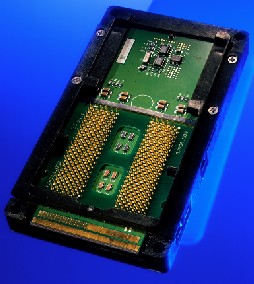Intel IDF Report #3 - Itanium
by Anand Lal Shimpi on February 17, 2000 12:00 PM EST- Posted in
- Trade Shows
The Chip
We managed to take a look at the Itanium processor first hand, and the CPU itself is a very interesting thing in itself.
The nature of the Itanium processor makes it necessary for multiprocessor configurations to be available at the launch of the processor. The workstation designs for the Itanium currently support 2-way MP configurations while the server designs support 4-way configurations.
The CPU itself is a socketed design, but there are no power pins on the connector. Instead of supplying power to the CPU via its connector pins, there is a separate power connector on the edge of the Itanium card itself that is used to supply power to the CPU. The reasoning behind this is that by supplying power to the CPU via a separate connector, Intel could decrease the pin count of the CPU itself while still maintaining a high density pin interface.
The chipset support is provided courtesy of the i460GX chipset, the successor to the i450GX, a high-end Slot-2 chipset. The 460GX supports PC100 SDRAM and PC1600 DDR SDRAM only, but we were given the impression that shipping Itanium systems would be using DDR SDRAM alone. The reason for using SDRAM & DDR SDRAM is because most high end servers and workstations feature large amounts of memory, and a more expensive memory technology such as RDRAM would increase the overall cost of Itanium servers by an almost unmanageable amount.
As we briefly alluded to earlier, the 460GX supports up to 4 processors in a very interesting physical configuration. Two processors can be supported via an extended ATX form factor motherboard, but a quad processor configuration is a bit more complicated. The quad processor board design features a double sided motherboard, with two CPU interface sockets on the top of the board and two on the bottom of the board. Because of this, a quad processor Itanium system can be considerably smaller than a quad processor Xeon setup which is a major consideration in the server environment where rack space is expensive.
Your average Itanium setup will probably come in a 7u case, which is a bit on the large side, but is still decent. According to Intel, the cost of ownership for an Itanium server should be in the same range as a Xeon server would be.











0 Comments
View All Comments